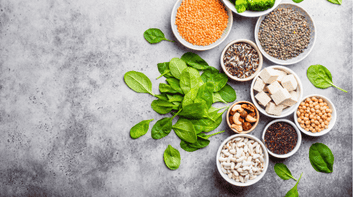
You already know that proteins are important – those amino acids are the building blocks of life! But when you are in your 40s, going through perimenopause, your body’s need for protein increases. The drop in your estrogen levels during perimenopause, can lead to loss in muscle mass and bone strength. The hormonal changes also make women more susceptible to weight gain around menopause. So you need to be eating a lot more lean protein to keep up. But if you’re a vegetarian, then some of the go-to protein-rich foods like lean meats and fish are out. So, how do vegetarians get a proper intake of protein?
Protein intake in a vegetarian diet.
It is a myth that vegetarians cannot get enough protein in their foods. But if you are not mindful of your diet, or you simply don’t know, then you may not be getting the right amount or quality of proteins that you need. While animal proteins contain all the essential amino acids we need, plant proteins can also be nutritious. In fact, in many ways a plant-based diet can be overall healthier for you. Research has associated vegetarian diets with a significant reduction in risk of blood pressure and type 2 diabetes, compared with non-vegetarian diets.
Most plant proteins don’t contain all essential amino acids (but some do! Read on below). So you need to get your proteins from a variety of sources. But not a problem, as there’s a lot to choose from! There are many options available for vegetarian proteins, and recently you might have even seen plant-based meats and seafood in the shops. Here are the best plant-based sources of proteins for vegetarians.
Soy-based foods (like tofu, soya nuggets)
Soybeans are considered complete sources of protein – that is, they are one of the few plant-based proteins to contain all nine essential amino acids. Tofu can be a versatile ingredient to use in your diet – cook it in your favorite sauces as you would do paneer. Or try some delectable Asian stir-fries loaded with veggies and protein. The dehydrated soya nuggets are another great option to add in your weekly meal rotation.
Beans, lentils and legumes
Lentils and legumes like rajma, choley, peas and dals are great sources of protein. A cooked cup of dal gives you about 18g of protein. They are also rich in fiber, folate, manganese, iron, antioxidants, and other nutrients. But remember, if you are having these proteins in your favourite curries (who doesn’t love some rajma-chawal?!) try to load up on the protein – the rajma or the dal, compared to the rice, to strike a healthier balance. Kidney beans and chickpeas are also great in salads – and easy enough to prepare that you can include it in your lunch a few days a week.
Quinoa
Not traditionally a part of the Indian diet, this grain has become a lot more popular now and for good reason. Quinoa is another complete vegetarian protein providing you all essential amino acids. It is also an excellent source of fiber, besides other vitamins and minerals. Including grains like quinoa in your diet may help reduce your risk of heart disease, Type 2 diabetes, and certain types of cancer. Quinoa is pretty easy to cook, and you can swap it out for rice for a more nutritious and carb-light accompaniment in your meal. You can also try quinoa in a salad, with your favourite colourful vegetables, or as a fried “rice” for a healthy delicious meal.
Nuts and seeds
Almonds, walnuts, pistachios, and chia seeds are all rich in proteins. A 1/4th cup of nuts like almonds or walnuts can provide about 6-9 grams of proteins. Nuts and seeds are also great sources of fiber and omega-3 fats, as well as other nutrients like iron, calcium, magnesium, selenium, phosphorus, vitamin E, and antioxidants. However, keep in mind that nuts can be quite calorie-rich … so eat in moderation. Include it with fruits as a snack or mix some in with your breakfast oats.
